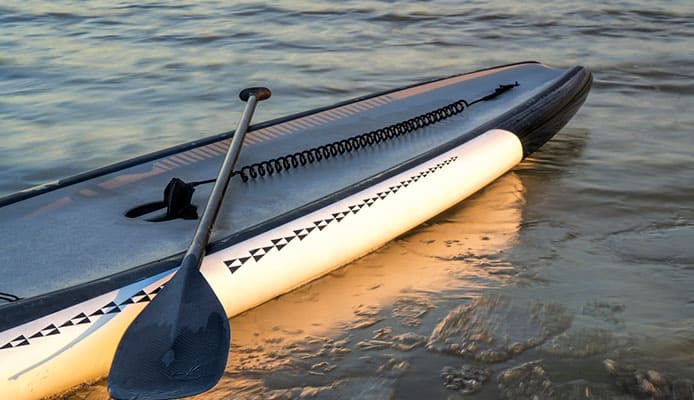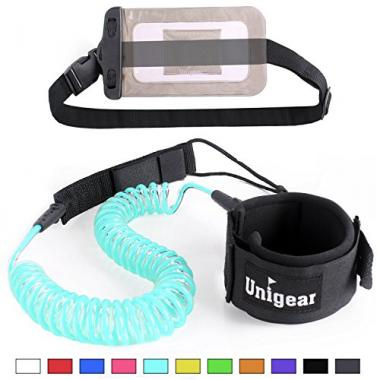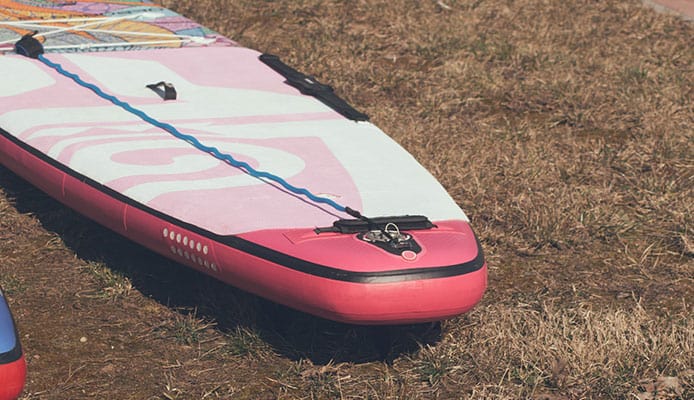
For paddleboard enthusiasts, next to the SUP paddle among the most important pieces of gear to always have is the paddleboard leash.
Small as it may appear, it can be the difference between life and death.
One of the main reasons why SUP leashes are so important is in case you found yourself in turbulent water and you happened to fall in, the leash will keep you attached to your paddleboard allowing you to recover and get back on it.
So, if you have been wondering whether you need a SUP leash, the answer is yes! You need to have a paddleboard leash attached to you before heading out onto the water.
Type of SUP leashes
There are two main types of SUP leashes. One is the coiled variety that is attached right below the knee. The benefit of this type of leash is that it doesn’t take too much space. Many ocean paddlers prefer it as it entangles less easily.
The other type of leash is the straight leash. It is often attached to the paddler’s foot right above the ankle. Often people find that it is more convenient to use especially in calmer conditions. The downside is that this type of leash will drag behind the SUP which some people don’t like.
The total length of the SUP leash should be about a foot longer than the length of the board. SUP leashes use Velcro to attach to the leg. Granted you may lose your paddleboard gear and equipment but the paddleboard remains within reach.
Leashes are lifesavers
If you were to fall in the water whether there are strong winds or even with a moderate breeze, your paddleboard is going to sail away from you. It would take a lot of effort to reach it and most times, it will just flow away faster than you can swim. Always wear a wetsuit if you are on cool waters.
This is the point we are making in this SUP leash guide.
This is why you need a leash to ensure that regardless of the situation, the paddleboard is close to you at all times. It could get life-threatening if you didn’t quickly get out of the water. If you are in cold water, for example, you could be at risk of hyperthermia.
Using a paddleboard in a river
Paddleboarding in rivers presents its share of challenges. For one, the leash may get tangled in branches or other obstacles if you happened to fall in. This is why it’s important to ensure that the method of attachment is quick and convenient.
A Velcro offers a quick release system making it among the best options for SUP leashes. Something to always take note of is to avoid fast rivers if you are a beginner using a beginner stand up paddleboard.
Surfing
If you are surfing with your all-around standup paddleboard, always make sure that you understand the risks involved. A strong wave may knock you off your board and drag you along as it winds and pulls the board underwater.
Secondly, the board could knock over some of the other SUP surfers nearby and may even cause injury. Using a SUP for surfing will thus require you to take extra care.
Always check conditions
One of the most important skills any outdoorsman should learn is knowing how to read the weather conditions. If for example there is a slight breeze, start your paddling by going directly into the breeze. In this way, once you are tired, you can enjoy an easy paddle back to shore.
Sometimes the wind may kick up when you are out on the water. Try and find out the direction it is coming from. You will need to paddle back to where you started and it doesn’t matter whether you will paddle against the winds.
What we are saying in this SUP leash guide is always have your leash on to help you stay close to your board when you fall into the water. Your bamboo paddleboard is your most important asset in such weather conditions.
As you paddle back to your initial position under the strong winds, you will need to maintain the surfer’s position. This means getting down and riding the waves while your head faces the nose of the paddleboard. Ensure you are aware of all the different parts of a standup paddleboard.
Take the paddle and place the blade right under your chest and make sure that the front face is looking towards your body. The handle of the paddle will now be beyond the nose of the board similar to the bow of the boat.
Ensure that it is aligned well along with the nose of the board.
At this point, it is your body weight that will be holding the paddle. You can then paddle with your hands. This decreases the wind resistance to your body allowing you to move faster towards the shore.
You might also like: checklist for Standup Paddleboarding Gear And Equipment
Another benefit of maintaining this position is that you can greatly reduce the chances of the paddleboard from tipping all while reducing the rocking. Never leave your board. Even while you fall into the water, try as much as you can to get back on it. You don’t want to risk hypothermia, after all.
Useful life-saving tip
There are plenty of amazing benefits for paddleboarding. Whenever you are paddleboarding in an area that you are not familiar with, however, you can always leave a note in your car stating where you were planning to go, what time you left, and what time you were planning on getting back.
Just in case you don’t make it back and you happen to get lost, this note will be useful to rescuers when trying to locate you.
Something else to take note of in this SUP leash guide is to always make sure you bring a friend along. You are much safer when it’s the two of you than if you were doing it alone.
Globo surf overview
Paddleboarding may be great fun, but two of the most important things that you want to make sure you always have are a life jacket and a paddleboard leash. The leash ensures that no matter the circumstances, you and your paddleboard are never separated. Often this can be a matter of life and death.
Paddle boards Guides:
How To Size Up Your SUP Paddle Correctly



